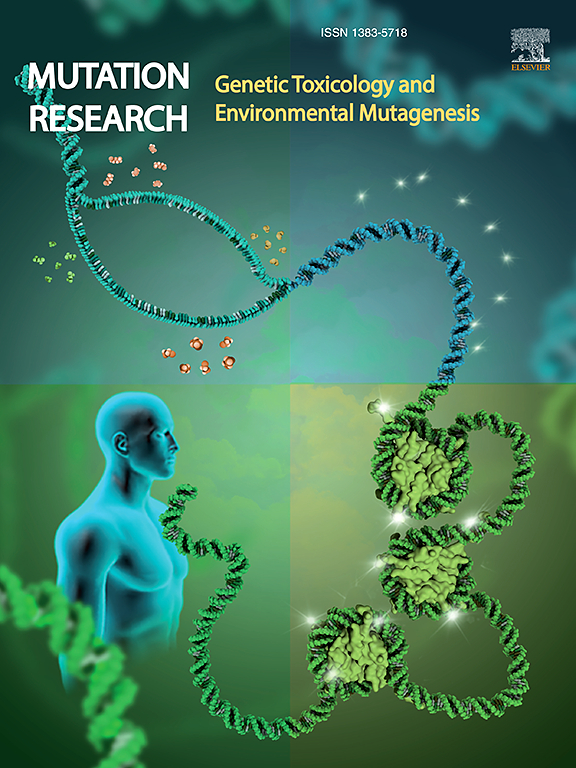Micronuclei as genotoxicity endpoint applied in the co-culture of two mammalian cell lines
IF 2.5
4区 医学
Q3 BIOTECHNOLOGY & APPLIED MICROBIOLOGY
Mutation research. Genetic toxicology and environmental mutagenesis
Pub Date : 2025-01-01
DOI:10.1016/j.mrgentox.2024.503839
引用次数: 0
Abstract
There has been a shift from traditional animal models towards alternative methods. While 2D cell culture has a decade long tradition, more advances methods like 3D cultures, organoids, and co-culture techniques, which better mimic in vivo conditions, are not yet well established in every research area. Genotoxicity assessment is an integral part of toxicological testing or regulatory approval of pharmaceuticals and chemicals. The micronucleus assay is now a standard method in this context. In this systematic literature review, we aim to describe the state of the art of the application of co-cultures of two mammalian cell lines for micronucleus assessment. We summarized the cell types used, methods for co-culture, disease models and agents, as well as the application of additional genotoxicity endpoints and viability tests. Airway system cells were the most frequent, followed by macrophage-like cells, liver cells, and various others. Co-culture techniques involve either direct physical contact or separation by porous membranes. Within a limited number of investigations using other genotoxicity assays like the comet and γH2AX assays in parallel, the micronucleus assay performed well. Overall, the micronucleus test demonstrating its suitability in disease models and for a more complex substance testing beyond simple 2D cultures, encouraging a more widespread use in co-culture systems in the future.
将微核作为遗传毒性终点应用于两种哺乳动物细胞系的共培养。
人们已经从传统的动物模型转向了替代方法。虽然2D细胞培养已经有十年的传统,但3D培养、类器官和共培养技术等更先进的方法,更好地模拟体内条件,尚未在每个研究领域都得到很好的建立。遗传毒性评估是药物和化学品的毒理学测试或监管批准的一个组成部分。微核化验现在是这方面的标准方法。在这个系统的文献综述中,我们的目的是描述两种哺乳动物细胞系共培养用于微核评估的应用现状。我们总结了使用的细胞类型,共培养方法,疾病模型和药物,以及其他遗传毒性终点和活力测试的应用。气道系统细胞是最常见的,其次是巨噬细胞样细胞、肝细胞和其他各种细胞。共培养技术包括直接物理接触或通过多孔膜分离。在使用其他遗传毒性测定方法(如comet和γH2AX测定)同时进行的有限数量的调查中,微核测定方法表现良好。总的来说,微核试验证明了它在疾病模型中的适用性,以及在简单的二维培养之外的更复杂的物质检测中,鼓励在未来的共培养系统中更广泛地使用。
本文章由计算机程序翻译,如有差异,请以英文原文为准。
求助全文
约1分钟内获得全文
求助全文
来源期刊
CiteScore
3.80
自引率
5.30%
发文量
84
审稿时长
105 days
期刊介绍:
Mutation Research - Genetic Toxicology and Environmental Mutagenesis (MRGTEM) publishes papers advancing knowledge in the field of genetic toxicology. Papers are welcomed in the following areas:
New developments in genotoxicity testing of chemical agents (e.g. improvements in methodology of assay systems and interpretation of results).
Alternatives to and refinement of the use of animals in genotoxicity testing.
Nano-genotoxicology, the study of genotoxicity hazards and risks related to novel man-made nanomaterials.
Studies of epigenetic changes in relation to genotoxic effects.
The use of structure-activity relationships in predicting genotoxic effects.
The isolation and chemical characterization of novel environmental mutagens.
The measurement of genotoxic effects in human populations, when accompanied by quantitative measurements of environmental or occupational exposures.
The application of novel technologies for assessing the hazard and risks associated with genotoxic substances (e.g. OMICS or other high-throughput approaches to genotoxicity testing).
MRGTEM is now accepting submissions for a new section of the journal: Current Topics in Genotoxicity Testing, that will be dedicated to the discussion of current issues relating to design, interpretation and strategic use of genotoxicity tests. This section is envisaged to include discussions relating to the development of new international testing guidelines, but also to wider topics in the field. The evaluation of contrasting or opposing viewpoints is welcomed as long as the presentation is in accordance with the journal''s aims, scope, and policies.

 求助内容:
求助内容: 应助结果提醒方式:
应助结果提醒方式:


